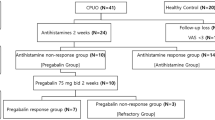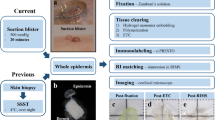Abstract
Itch, also known as pruritus, is an unpleasant cutaneous sensation that provokes the desire to scratch. Itch is a common symptom of inflammatory skin disorders, but it can also occur in neurological diseases associated with injury to nervous tissue, in the absence of any skin disease and without any notable physiological stimuli in the periphery. This 'neuropathic' type of itch occurs either in combination with neuropathic pain or independently and is thought to be underdiagnosed. In this Review, we describe the physiological characteristics of specific neuronal systems in the PNS and CNS that transmit and process pruriceptive information, and we consider pathological changes that occur in these systems after nerve lesions. We then introduce a classification system for itch and highlight the similarities and differences between neuropathic itch and neuropathic pain. A summary of neuropathic syndromes in the PNS and CNS that are associated with itch is presented. Finally, we propose appropriate treatment strategies for neuropathic itch, in view of the fact that this condition has different mechanisms of itch generation to other types of itch and consequently requires different therapies.
Key Points
-
Neuropathic itch is a common symptom after nerve lesions
-
Neuropathic itch can occur in combination with neuropathic pain or independently
-
Lesions in the PNS and the CNS can both give rise to neuropathic itch
-
There are striking similarities in the mechanisms of generation of neuropathic pain and neuropathic itch
-
Neuropathic itch is treated differently from itch in skin disorders
-
Antidepressants, anticonvulsants and topical capsaicin are treatment options for neuropathic itch
This is a preview of subscription content, access via your institution
Access options
Subscribe to this journal
Receive 12 print issues and online access
$209.00 per year
only $17.42 per issue
Buy this article
- Purchase on Springer Link
- Instant access to full article PDF
Prices may be subject to local taxes which are calculated during checkout


Similar content being viewed by others
References
Rothman S (1941) Physiology of itching. Physiol Rev 21: 357–381
Ikoma A et al. (2006) The neurobiology of itch. Nat Rev Neurosci 7: 535–547
Schmelz M et al. (2003) Chemical response pattern of different classes of C-nociceptors to pruritogens and algogens. J Neurophysiol 89: 2441–2448
Schmelz M et al. (1997) Specific C-receptors for itch in human skin. J Neurosci 17: 8003–8008
Ikoma A et al. (2005) Electrically evoked itch in humans. Pain 113: 148–154
Andrew D and Craig AD (2001) Spinothalamic lamina I neurons selectively sensitive to histamine: a central neural pathway for itch. Nat Neurosci 4: 72–77
Simone DA et al. (1991) Psychophysical studies of the itch sensation and itchy skin (“alloknesis”) produced by intracutaneous injection of histamine. Somatosens Mot Res 8: 271–279
Atanassoff PG et al. (1999) Enhancement of experimental pruritus and mechanically evoked dysesthesiae with local anesthesia. Somatosens Mot Res 16: 291–298
Baron R (2006) Mechanisms of disease: neuropathic pain—a clinical perspective. Nat Clin Pract Neurol 2: 95–106
Ward L et al. (1996) A comparison of the effects of noxious and innocuous counterstimuli on experimentally induced itch and pain. Pain 64: 129–138
Yosipovitch G et al. (2005) Noxious heat and scratching decrease histamine-induced itch and skin blood flow. J Invest Dermatol 125: 1268–1272
Nilsson HJ et al. (1997) Cutaneous field stimulation (CFS): a new powerful method to combat itch. Pain 71: 49–55
Mochizuki H et al. (2003) Imaging of central itch modulation in the human brain using positron emission tomography. Pain 105: 339–346
Szarvas S et al. (2003) Neuraxial opioid-induced pruritus: a review. J Clin Anesth 15: 234–239
Twycross R et al. (2003) Itch: scratching more than the surface. QJM 96: 7–26
Grewe M et al. (2000) Neurotrophin-4 production by human epidermal keratinocytes: increased expression in atopic dermatitis. J Invest Dermatol 114: 1108–1112
Steinhoff M et al. (2006) Neurophysiological, neuroimmunological, and neuroendocrine basis of pruritus. J Invest Dermatol 126: 1705–1718
Bergasa NV and Jones EA (1995) The pruritus of cholestasis: potential pathogenic and therapeutic implications of opioids. Gastroenterology 108: 1582–1588
Bergasa NV (2004) Treatment of the pruritus of cholestasis. Curr Treat Options Gastroenterol 7: 501–508
Mansour-Ghanaei F et al. (2006) Effect of oral naltrexone on pruritus in cholestatic patients. World J Gastroenterol 12: 1125–1128
Jones EA and Bergasa NV (1990) The pruritus of cholestasis: from bile acids to opiate agonists. Hepatology 11: 884–887
Calikusu C et al. (2003) The relation of psychogenic excoriation with psychiatric disorders: a comparative study. Compr Psychiatry 44: 256–261
Trabert W (1995) 100 years of delusional parasitosis: meta-analysis of 1,223 case reports. Psychopathology 28: 238–246
Ständer S et al. (2007) Clinical classification of itch: a position paper of the International Forum for the Study of Itch. Acta Derm Venereol 87: 291–294
Binder A et al. (2008) A case of neuropathic brachioradial pruritus caused by cervical disc herniation. Nat Clin Pract Neurol [10.1038/ncpneuro0807]
Galer BS and Jensen MP (1997) Development and preliminary validation of a pain measure specific to neuropathic pain: the Neuropathic Pain Scale. Neurology 48: 332–338
Oaklander AL et al. (2003) Herpes zoster itch: preliminary epidemiologic data. J Pain 4: 338–343
Dunphy FR et al. (1997) A phase I report of paclitaxel dose escalation combined with a fixed dose of carboplatin in the treatment of head and neck carcinoma. Cancer 79: 2016–2023
Singh F and Rudikoff D (2003) HIV-associated pruritus: etiology and management. Am J Clin Dermatol 4: 177–188
Weidemann F et al. (2008) Misleading terms in Anderson–Fabry disease. Eur J Clin Invest 38: 191–196
Savk E et al. (2000) Notalgia paresthetica: a study on pathogenesis. Int J Dermatol 39: 754–759
Cohen AD et al. (2003) Brachioradial pruritus: a symptom of neuropathy. J Am Acad Dermatol 48: 825–828
Wallengren J and Sundler F (2005) Brachioradial pruritus is associated with a reduction in cutaneous innervation that normalizes during the symptom-free remissions. J Am Acad Dermatol 52: 142–145
Wallengren J (2005) Neuroanatomy and neurophysiology of itch. Dermatol Ther 18: 292–303
Cohen AD et al. (2005) Neuropathic scrotal pruritus: anogenital pruritus is a symptom of lumbosacral radiculopathy. J Am Acad Dermatol 52: 61–66
Jacome D (1978) Phantom itching relieved by scratching phantom feet. JAMA 240: 2432
Lee SS et al. (2004) Pruritus, pain, and small nerve fiber function in keloids: a controlled study. J Am Acad Dermatol 51: 1002–1006
Metze D et al. (1997) Persistent pruritus after hydroxyethyl starch infusion therapy: a result of long-term storage in cutaneous nerves. Br J Dermatol 136: 553–559
Canavero S et al. (1997) Central neurogenic pruritus: a literature review. Acta Neurol Belg 97: 244–247
Adreev VC and Petkov I (1975) Skin manifestations associated with tumours of the brain. Br J Dermatol 92: 675–678
King CA et al. (1982) Unilateral neurogenic pruritus: paroxysmal itching associated with central nervous system lesions. Ann Intern Med 97: 222–223
Shabtai H et al. (1996) Pruritus in Creutzfeldt–Jakob disease. Neurology 46: 940–941
Yamamoto M et al. (1981) Paroxysmal itching in multiple sclerosis: a report of three cases. J Neurol Neurosurg Psychiatry 44: 19–22
Sandyk R (1994) Paroxysmal itching in multiple sclerosis during treatment with external magnetic fields. Int J Neurosci 75: 65–71
Ostermann PO and Westerberg CE (1975) Paroxysmal attacks in multiple sclerosis. Brain 98: 189–202
Magilner D (2006) Localized cervical pruritus as the presenting symptom of a spinal cord tumor. Pediatr Emerg Care 22: 746–747
Dey DD et al. (2005) Central neuropathic itch from spinal-cord cavernous hemangioma: a human case, a possible animal model, and hypotheses about pathogenesis. Pain 113: 233–237
Oaklander AL et al. (2002) Intractable postherpetic itch and cutaneous deafferentation after facial shingles. Pain 96: 9–12
Bernhard JD (2005) Itch and pruritus: what are they, and how should itches be classified. Dermatol Ther 18: 288–291
Baron R et al. (2001) Histamine-induced itch converts into pain in neuropathic hyperalgesia. Neuroreport 12: 3475–3478
Schmelz M (2006) Complex interactions between pain and itch. Pain 124: 9–10
Biro T et al. (2007) TRP channels as novel players in the pathogenesis and therapy of itch. Biochim Biophys Acta 1772: 1004–1021
Stander S et al. (2001) Treatment of prurigo nodularis with topical capsaicin. J Am Acad Dermatol 44: 471–478
Inoue K et al. (2002) Functional vanilloid receptors in cultured normal human epidermal keratinocytes. Biochem Biophys Res Commun 291: 124–129
Carstens E and Jinks SL (1998) Skin cooling attenuates rat dorsal horn neuronal responses to intracutaneous histamine. Neuroreport 9: 4145–4149
Savk E et al. (2001) Open pilot study on oxcarbazepine for the treatment of notalgia paresthetica. J Am Acad Dermatol 45: 630–632
Rogawski MA and Loscher W (2004) The neurobiology of antiepileptic drugs for the treatment of nonepileptic conditions. Nat Med 10: 685–692
Bueller HA et al. (1999) Gabapentin treatment for brachioradial pruritus. J Eur Acad Dermatol Venereol 13: 227–228
Yesudian PD and Wilson NJ (2005) Efficacy of gabapentin in the management of pruritus of unknown origin. Arch Dermatol 141: 1507–1509
Winhoven SM et al. (2004) Brachioradial pruritus: response to treatment with gabapentin. Br J Dermatol 150: 786–787
Taylor RS (1998) Multiple sclerosis potpourri: paroxysmal symptoms, seizures, fatigue, pregnancy, and more. Phys Med Rehabil Clin N Am 9: 551–559, vi
Zylicz Z et al. (2003) Paroxetine in the treatment of severe non-dermatological pruritus: a randomized, controlled trial. J Pain Symptom Manage 26: 1105–1112
Summey BT Jr and Yosipovitch G (2005) Pharmacologic advances in the systemic treatment of itch. Dermatol Ther 18: 328–332
Elkersh MA et al. (2003) Epidural clonidine relieves intractable neuropathic itch associated with herpes zoster-related pain. Reg Anesth Pain Med 28: 344–346
Dawn AG and Yosipovitch G (2006) Butorphanol for treatment of intractable pruritus. J Am Acad Dermatol 54: 527–531
Acknowledgements
The authors' work is supported by the German Ministry of Research and Education, German Research Network on Neuropathic Pain (BMBF, 01EM01/04) and an unrestricted educational grant from Pfizer, Germany.
Author information
Authors and Affiliations
Corresponding author
Ethics declarations
Competing interests
A Binder has received honoraria from Pfizer, Allergan and Grünenthal. R Baron has acted as a consultant and received honoraria and grant support from Genzyme and Pfizer, and has acted as a consultant and received honoraria from Allergan, Grünenthal, Medtronic, Mundipharma and Sanofi Pasteur MSD. J Koroschetz declared no competing interests.
Rights and permissions
About this article
Cite this article
Binder, A., Koroschetz, J. & Baron, R. Disease mechanisms in neuropathic itch. Nat Rev Neurol 4, 329–337 (2008). https://doi.org/10.1038/ncpneuro0806
Received:
Accepted:
Published:
Issue Date:
DOI: https://doi.org/10.1038/ncpneuro0806
This article is cited by
-
Neuropathischer Pruritus – evidenzbasierte Behandlungsempfehlungen
Der Nervenarzt (2023)
-
Assessing and Treating Chronic Pain in Patients with End-Stage Renal Disease
Drugs (2018)
-
Psychological defensive profile of sciatica patients with neuropathic pain and its relationship to quality of life
Zeitschrift für Rheumatologie (2015)
-
Neuropathic pruritus
Nature Reviews Neurology (2014)
-
Schmerzen und Jucken
Der Hautarzt (2012)



